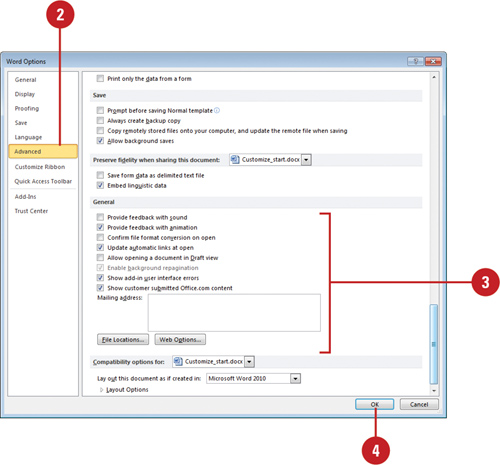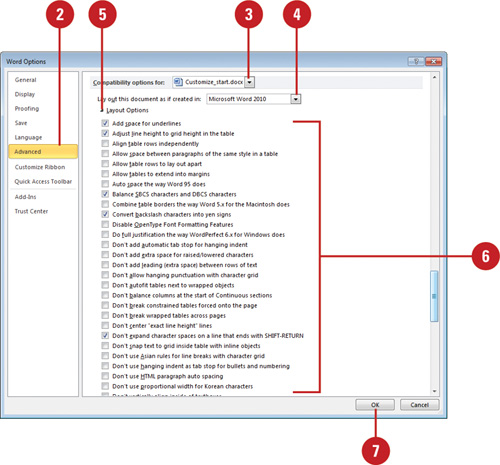Setting Advanced General Options
In
addition to display options, the Advanced pane in Word Options also
includes options to provide general user feedback. You can set the
feedback options to play sound, show simple animation, show add-in user
interface error, or display alerts to update links. You can also set
options for default file locations, Web pages, and shared workspaces
using the File Locations, Web Options, and Service buttons.
Change Advanced General Options
 Click the File tab, and then click Options.
Click the File tab, and then click Options.
 In the left pane, click Advanced.
In the left pane, click Advanced.

 Select the general options you want:
Select the general options you want:
- Provide feedback with sound. (Default off).
- Provide feedback with animation. (Default on).
- Confirm file format conversion on open. Select to choose a file converter. (Default off).
- Update automatic links at open. (Default on).
- Allow opening a document in Draft view. (Default off).
- Enable background repagination. Select to repaginate documents as needed. (Default on).
- Show add-in user interface errors. Select to display alerts for custom interface problems. (Default off).
- Show customer submitted Office.com content. (New!) Select to show customer content from Office.com. (Default on).
- Mailing address. Enter to use as the default return address for envelopes and letters.
 Click OK.
Click OK.
If you always save
documents in a specific folder, you can change the default location
where documents are saved. You can change the default file location for
documents, clip art pictures, user templates, workgroup templates,
AutoRecover files, tools, and startup. Unless you fully understand the
internal connects between Word and the clip art, tools, and startup
folders, you should not change those default file locations. After you
make a change, Word uses the new setting for all subsequent Word
sessions until you change the setting again. In the Advanced pane of the
Word Options dialog box, click File Locations, select the file type you
want to change, click Modify, open the new default folder location,
click OK, and then click OK.
Setting Compatibility Options
If
you have an older Word or WordPerfect document that doesn’t display
very well in Word 2010, you can set compatibility options to simulate
the layout of an older format to improve the display. Word 2010 provides
compatibility for all previous versions of Word going back to Word for
Windows 1.0 and WordPerfect 5.x. Compatibility options are available on
the Advanced pane in Word Options. After you select the layout version
you want to use, you click the arrow to display the long list of
compatibility options.
Change Compatibility Options
 Click the File tab, and then click Options.
Click the File tab, and then click Options.
 In the left pane, click Advanced, and then scroll to the bottom of the dialog box.
In the left pane, click Advanced, and then scroll to the bottom of the dialog box.

 Click the Compatibility options for list arrow, and then select the document in which you want to set options.
Click the Compatibility options for list arrow, and then select the document in which you want to set options.
 Click the Layout this document as if created in list arrow, and then select the version of Word you want.
Click the Layout this document as if created in list arrow, and then select the version of Word you want.
 Click the arrow next to Layout Options.
Click the arrow next to Layout Options.
 Select or clear the layout check box options in the list.
Select or clear the layout check box options in the list.
 Click OK.
Click OK.